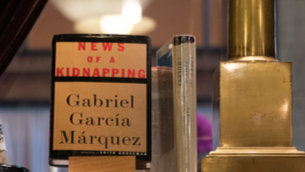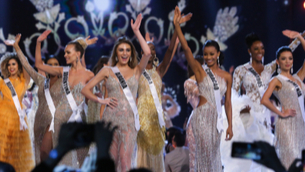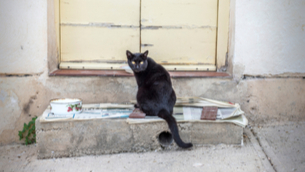| Ceci: | “El voto que hemos conquistado es una herramienta nueva en nuestras manos. Pero nuestras manos no son nuevas en las luchas, en el trabajo y en el milagro repetido de la creación.” Rylan, can you guess who uttered these famous words? |
| Rylan: | Hmm, sounds familiar. And sounds pretty old, too. |
| Ceci: | Sí, es antiguo. El año es 1947. (Nineteen forty-seven). |
| Rylan: | Y es mujer, obviamente. |
| Ceci: | Claro que sí. |
| Rylan: | ¿Es latinoamericana? |
| Ceci: | Sí. Es de Argentina. |
| Rylan: | ¿Es actriz? |
| Ceci: | Sí. Es actriz y también es cantante. |
| Rylan: | Es una mujer argentina, es actriz, es cantante… ¿Está viva? |
| Ceci: | Ahora ya no está viva. I’ll give you another clue: Ella está casada con un presidente. Ella es un ícono del populismo y los trabajadores. |
| Rylan: | I think I got it. No llores por mí Argentina, mi alma está contigo… ¡Evita! |
| Ceci: | You got it! Eva Perón. A woman who was and still is many different things, even decades after her death. A polarizing historical figure who has reached mythical status! I think she’s a great way to introduce our subject for today: To be - Los verbos ser y estar. |
| Rylan: | Evita: La mujer, la líder, la leyenda… I love that idea! But uh, how do we transition to the lesson now? Oh! Should I sing the rest of that song? |
| Ceci: | Actually, I’m sure our audience would be delighted but I brought a sample from what I think is the definitive performance. |
| Rylan: | ¿Madonna? |
| Ceci: | ¡Paloma San Basilio! Roll the clip! ... ¡Qué voz apasionada! |
| Rylan: | Muy bonita. |
| Ceci: | You know, I once had a student ask me why she sings “mi alma está contigo” and not “mi alma es contigo”. |
| Rylan: | Shakespeare was wrong, Ceci. |
| Ceci: | ¿Qué? |
| Rylan: | Yup, the question is not to be or not to be. |
| Ceci: | Oh, no? |
| Rylan: | Nope! The question, at least in Spanish, is rather: To be OR to be. |
| Ceci: | Ser o Estar... |
| Rylan: | Ésa es… ¡la confusión! ...Most Spanish books teach that ser is permanent and estar is temporary. But isn’t her soul… su alma always with Argentina? |
| Ceci: | Yes, that is what the sentence implies. |
| Rylan: | So, ser isn’t the only way to express that something is permanent after all. |
| Ceci: | That’s true, and that’s why it can be helpful to memorize lists of…. |
| Rylan: | Ceci, hold on a second, do you really think it’s helpful in everyday life to walk around with memorized lists in your head of which verbs and situations go together? |
| Ceci: | It’s the only way. |
| Rylan: | No estoy de acuerdo contigo... I have to disagree with you on that. I bet with just 2 simple words we can finally get the hang of ser y estar and move from confusión to solución. |
| Ceci: | And those 2 words are? |
| Rylan: | Essence and condition. |
| Ceci: | Hmm, I’m intrigued. Continúa… |
| Rylan: | When using the verb to be, almost everything falls into one of these two categories: the essence – what something is; what defines it – and the condition – how or where something is at any given time. When deciding between ser or estar, ask yourself if you’re talking about essence or condition rather than “permanent” or “temporary,” or relying on memorized lists and patterns. |
| Ceci: | Ok, let’s put it to the test. Give me some examples of essence with ser. |
| Rylan: | Ceci es colombiana. Ceci es mujer. Ceci es inteligente. Rylan es americano. Rylan es guapo. |
| Ceci: | So, ser talks about essence, and it’s also used to tell the time, talk about your profession, and physical appearance… Por ejemplo: son las 2 de la tarde, eres lingüista, eres… alto, moreno, y guapo. |
| Rylan: | Muchas gracias… On the other hand, estar is talking about something’s condition or location. |
| Ceci: | Tú y yo estamos en el estudio, estamos sentados, estamos contentos. |
| Rylan: | Oye, ¿Dónde está tu teléfono? |
| Ceci: | ¿Mi celular? Está en mi oficina. |
| Rylan: | ¿Y dónde está... el alma, Ceci? |
| Ceci: | ¿EL alma? ¿Estás loco? |
| Rylan: | El alma de Eva Perón siempre está con Argentina… She uses estar because she’s talking about the location of her soul, its place, and it has nothing to do with being permanent or temporary. |
| Ceci: | ¡Eres muy listo! |
| Rylan: | Bueno, un poco, sí… So, just about everything we say in English using the verb to be falls into either category: essence or condition. |
| Ceci: | Do you know about the green apple, Rylan? |
| Rylan: | ¿La manzana verde? |
| Ceci: | Sí. Would you say la manzana es verde, o la manzana está verde? |
| Rylan: | La manzana está verde, la manzana es verde, es verde, está verde… They both sound correct! |
| Ceci: | That’s because they are, but the meaning changes slightly when you use ser or estar. |
| Rylan: | Oh yeah, la manzana está verde means that the apple isn’t ripe yet, and la manzana es verde means… it’s a green apple. A granny smith! |
| Ceci: | Exactly. A moment ago, I said “eres muy listo”, but if I say “estás listo”... |
| Rylan: | That means I’m ready to go. Soy listo means I’m clever, estoy listo means I’m ready. |
| Ceci: | Ser is the essence, and estar is the condition. Clever describes what you are, and ready describes how you are right now. There are many words like this in Spanish, which change meaning when you use ser or estar. |
| Rylan: | They’re all adjectives and we’ll discuss them in our next lesson. |
| Ceci: | Ok, let’s not get ahead of ourselves. What about those little words tú y yo? Do our listeners remember all the subject pronouns? |
| Rylan: | Yo, tú, el/ella/usted, nosotros, ellos/ellas y ustedes. These? The words for I… |
| Ceci: | Yo. |
| Rylan: | You (informal)... |
| Ceci: | Tú. |
| Rylan: | He/she, and you (formal)... |
| Ceci: | Él/ella/usted. |
| Rylan: | We... |
| Ceci: | Nosotros. |
| Rylan: | And they/you all? |
| Ceci: | Ellos/ellas/ustedes. |
| Rylan: | Yeah, I think they do. Hey, what about vosotros? The word for “you guys,” – a group of friends – Does everybody need to learn that one? |
| Ceci: | Vosotros is pretty much only used in Spain these days. Yo soy colombiana, and most Latin Americans don’t really use that word. We use ustedes for formal and informal situations. The good news is that we all understand each other, no matter which we use. |
| Rylan: | One more thing: when I was in Argentina, I heard people using vos instead of tú. |
| Ceci: | Sí, es verdad… some regions of the world have their own varieties of Spanish, but yo, tú, él/ella/usted, nosotros, y ustedes are used in every form of Spanish, so if we learn and use those, we’ll always understand and be understood. |
| Rylan: | Well, that clears that up. I guess all that’s left to cover is the rap. |
| Ceci: | ¿El qué? |
| Rylan: | We just have to teach our listeners to rap the verb forms so they can get them to stick… and stay fresh in their minds. |
| Ceci: | Pero Rylan, es una broma. ¿Estás en las nubes? ¿Somos profesores o somos cantantes? |
| Rylan: | ¡Somos los dos! |
| Ceci: | Rylan, yo soy una profesora de español y soy realista. La lección es importante. Y ahorita... yo estoy preocupada. |
| Rylan: | Don’t worry, Ceci. I know. Las lecciones de español son importantes, y yo también soy profesor de español y soy... idealista... Just try it. Repeat after me: Soy, eres, es, somos, y son. |
| Ceci: | Soy, eres, es, somos, y son. |
| Rylan: | Estoy, estás, está, estamos, y están. |
| Ceci: | Estoy, estás, está, estamos, y están. |
| Rylan: | Soy eres es, somos, y son. Estoy estás está, estamos, y están. Cool, ¿no? |
| Ceci: | Bueno, I have to admit that it does tend to stick in your mind a little easier. |
| Rylan: | It’s also scientifically proven that we remember music and rhythm faster and easier than lists of words or charts or graphs. When’s the last time you were walking down the street with a pie chart stuck in your head? |
| Ceci: | I guess you have a point. |
| Rylan: | Otro juego antes de terminar... Let’s play another game. Speaking of Eva Perón, let’s see if you can guess who said these... citas famosas, ¿de acuerdo? |
| Ceci: | Dime. |
| Rylan: | La infancia feliz es un mito. |
| Ceci: | A happy childhood is a myth. |
| Rylan: | En todo caso es mejor morir tratando de escapar, que morir sin luchar. |
| Ceci: | In any case, it’s better to die trying to escape, than to die without fighting. |
| Rylan: | Para las mujeres, el mejor afrodisíaco son las palabras. |
| Ceci: | For women, words are the greatest aphrodisiac. |
| Rylan: | ¿Sabes quién es? |
| Ceci: | Está clarísimo quién es. |
| Rylan: | ¿Sí? ¿Estás segura? |
| Ceci: | Claro que estoy segura. Es la periodista y autora chileno-americana, Isabel Allende. |
| Rylan: | ¡Bravo! |
| Ceci: | Bueno, repasemos… Let’s review... “Ser” es para la esencia. |
| Rylan: | Y “estar” es para la condición. |
| Ceci: | Yo soy realista, tú eres idealista. |
| Rylan: | Tú estás preocupada, yo estoy relajado. |
| Ceci: | Bueno, ya no estoy preocupada, pero un poco dudosa… I have my doubts. |
| Rylan: | Está bien… That’s fine! I’ll take “dudosa” over “preocupada” any day. |
| Ceci: | Ok, estamos de acuerdo. |

























